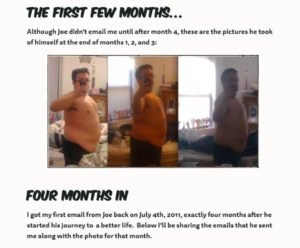Have you ever listened to a presentation, completely forgotten the key message but remembered the stories within it?
3 essential stories for your eCommerce website
We all have. That’s because our brains become more active when we listen to stories (compared to data points, facts and theories) (Buffer).
By telling stories, we can even plant ideas, thoughts and emotions into people’s brains.
When it comes to making a purchase on your eCommerce website, a good story can make the difference between a potential customer becoming enchanted by your product and ignoring it altogether.
So, we need stories. But what type of stories should you include on your eCommerce website?
In this article, you’ll learn 3 story frameworks you can use on your eCommerce website.
These stories will help you connect with your prospects, differentiate your brand, and ultimately drive more sales of your products.
1. The humble founder story
Every founder has a unique story to tell of how their company started.
To tell a great founder story, write about the vision and struggle that ultimately led to the company’s success. Stay away from producing a dull chronological overview of your company from inception to present-day, and push yourself to create a more personal and interesting narrative.
Why it works: This story explains why your product matters by describing why it was created in the first place. It might be a personal experience of the problem your product solves or a vision of a better world (or home, or workplace). Sharing your humble beginnings also enables you to connect with prospects on a personal level.
Example: Warby Parker was founded with the rebellious objective to overcome the problem of expensive eyewear. Inspiration for the business came from personal experience with this issue. One of the company’s founders lost his glasses on a backpacking trip. Facing steep costs as a poor grad student, he couldn’t afford to replace them.

How to do it: Go back to the company’s roots and ask yourself: How did you come to start this business? What were the breakthrough moments or unique circumstances that stimulated its establishment? Pick out the highlights, and weave them into your own story.
2. The visionary purpose story
Every company has a purpose. Use story to help your customers understand the company’s reason for being and vision for a better world. Like the founder story, the purpose story also looks at the company’s roots but is forward looking (in contrast to the founder story which looks backwards).
Why do it: Sharing the company’s ‘big picture’ vision will inspire people to support your venture, including prospective customers, partners and employees. Using a purpose story also helps your ideal customer understand why your product was made for a person just like them.
Example: Hiut Denim tells the story of how they re-employed people who lost their jobs when the factories closed. They go on to explain their vision to make jeans great again by leveraging local talent in the town: To bring manufacturing back home. To use all that skill on our doorstep. And to breathe new life into our town.

How to do it: Ask yourself why your company was founded. What problem were you trying to solve or mission did you aspire to achieve? How are you continuing to contribute towards that goal?
3. The customer transformation story
Inspirational stories are the hallmark of many classic tales and blockbuster movies. Brands tell inspirational stories about their customers through the transformation their products enabled.
Why do it: The customer transformation story enables your ideal customer to recognize their problem and learn about a specific solution. Using story enables you to present a strong visualization of the solution which they can imagine in their own life.
Example: Nerd Fitness uses case studies of their customers to demonstrate the transformation that customers experienced after joining the academy. Before and after body photographs supported by month-by-month progress reports present a vivid illustration that the fitness academy works.

How to do it: Identify a specific problem faced by your ideal customer. Highlight the struggle they go through to overcome it. Close your story with a resolution in the form of your product. Use the BAB formula (AKA, the before, after, bridge formula) to help you (Campaign Monitor).
People have been telling stories since the dawn of communication. Today, smart eCommerce websites are leveraging the power of story to connect with the customers and sell more products.
Using story can help can make you more relatable, your business more worthy and your product more attractive.
But not just any story will do. You need to tell heartfelt stories that will resonate with your target audience and will be remembered in years to come.
To do this, tell simple stories where people can immediately understand the message. Draw out the pivotal moments in your stories and tell them in a straightforward language that your customers use.
The simpler a story, the more likely it will stick. That’s the end of this story.
What are your top storytelling tips? What types of stories do you tell on your eCommerce website? Share your thoughts in the comments.
For more business tips, check our entrepreneurship section and subscribe to our weekly newsletters.






![The 15 best finance websites you should bookmark right now [2025 Edition] alphagamma The 15 best finance websites you should bookmark right now [2025 Edition] entrepreneurship finance opportunities](https://agcdn-1d97e.kxcdn.com/wp-content/uploads/2024/09/alphagamma-The-15-best-finance-websites-you-should-bookmark-right-now-2025-Edition-entrepreneurship-finance-opportunities-300x350.jpg)